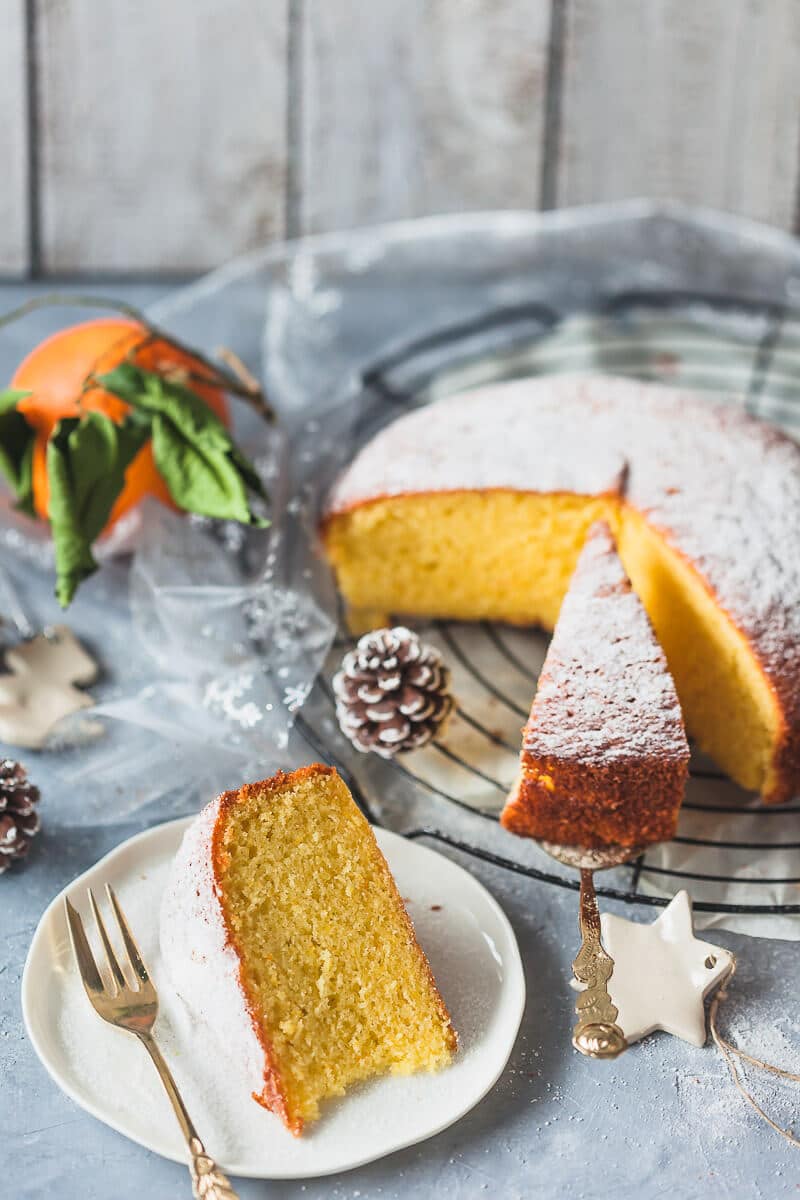A simple, delicious, dairy-free Olive Oil Orange Cake is light and fluffy with a strong orange flavor.
To finish the year style here’s an easy dessert to serve at your New Year’s Eve Dinner, the Olive Oil Orange Cake.
This cake may look simple, but it packs a powerful flavor of oranges and subtle olive oil notes. This Olive Oil Orange Cake is so fluffy and light, you will immediately want seconds!
It is no wonder it is always one of the most popular recipes on our blog in winter.
This isn’t just any cake—it’s a slice of sunshine! ☀️ Here’s why you NEED to try it:
✨ Naturally Dairy-Free: the cake is made with luscious olive oil instead of butter, and is perfectly moist and rich without any dairy.
🍊 Bursting with fresh orange flavor: Using whole organic oranges means that every bite is infused with a zesty, citrusy flavor!
🥚 Made with Love (and free-range eggs): free-range eggs bring a richer flavor and make this cake fluffy and light. Because baking should be as ethical as it is delicious.
💨 Quick & Easy: Mix, bake, dust with icing sugar, and voilà! A homemade masterpiece that feels fancy but takes no time.
🕊️ Perfect for breakfast, tea time, or dessert – pair it with coffee for a match made in heaven.
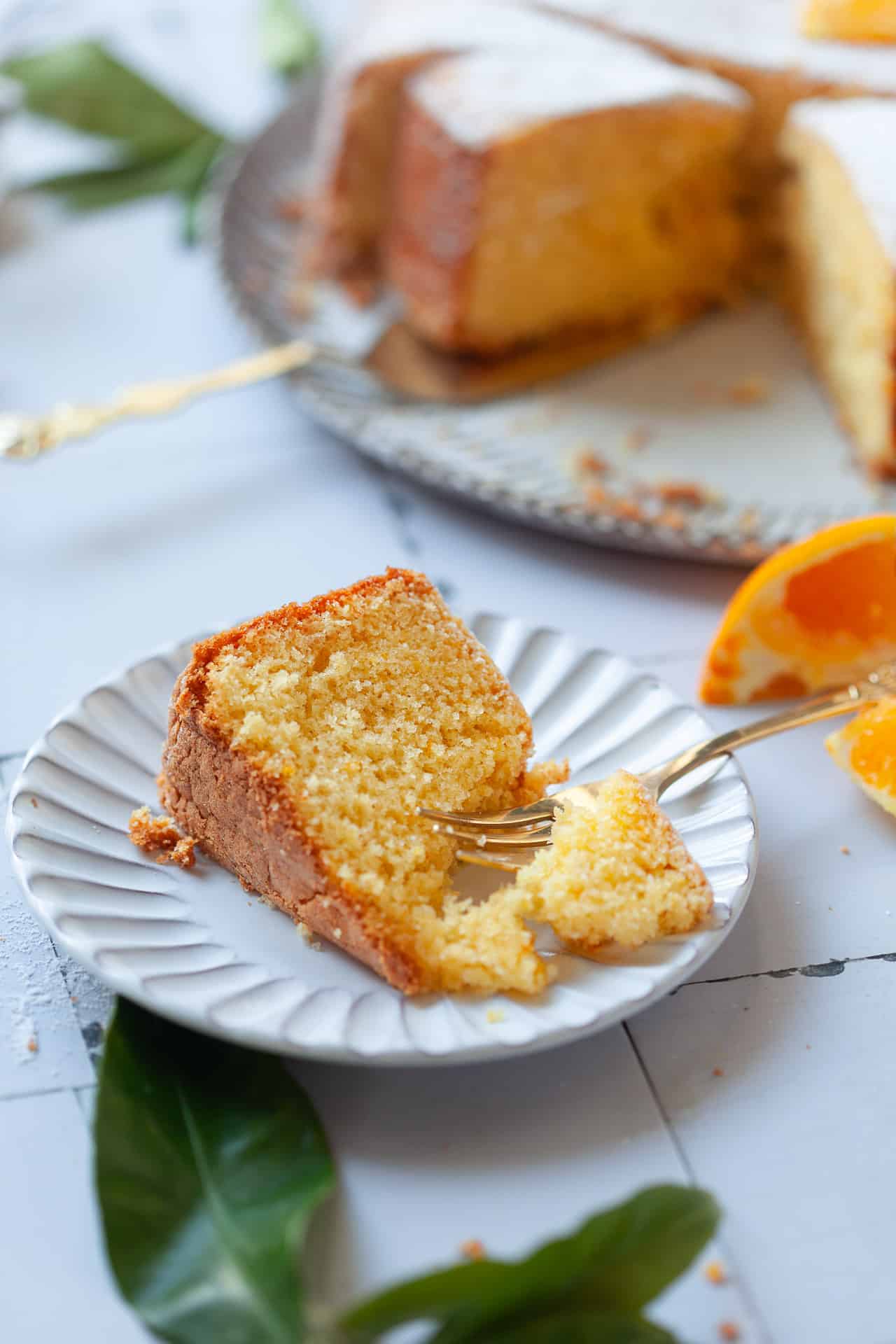
Olive Oil Orange Cake Ingredients
This recipe is super simple, only uses a handful of basic ingredients, and is one of my favorite recipes to make – quick, easy, just toss everything in a food processor and bake!
It is the perfect cake to serve when you have unexpected guests.
To make this cake you will only need:
- 3 large eggs
- granulated sugar
- 2 small organic oranges
- olive oil
- all-purpose flour
- baking powder
- pinch of salt.
Optionally you can also add some vanilla extract, and decorate the baked cake with icing sugar and some orange slices.
The zest (the outer layer of the peel) is a key ingredient, and this part of the fruit is where pesticides, waxes, or other chemicals are most likely to accumulate, so it is very important to use untreated organic oranges in this recipe.
When zesting oranges for recipes like this, always wash and dry the fruit thoroughly – even if it’s organic – for the cleanest and freshest flavor.
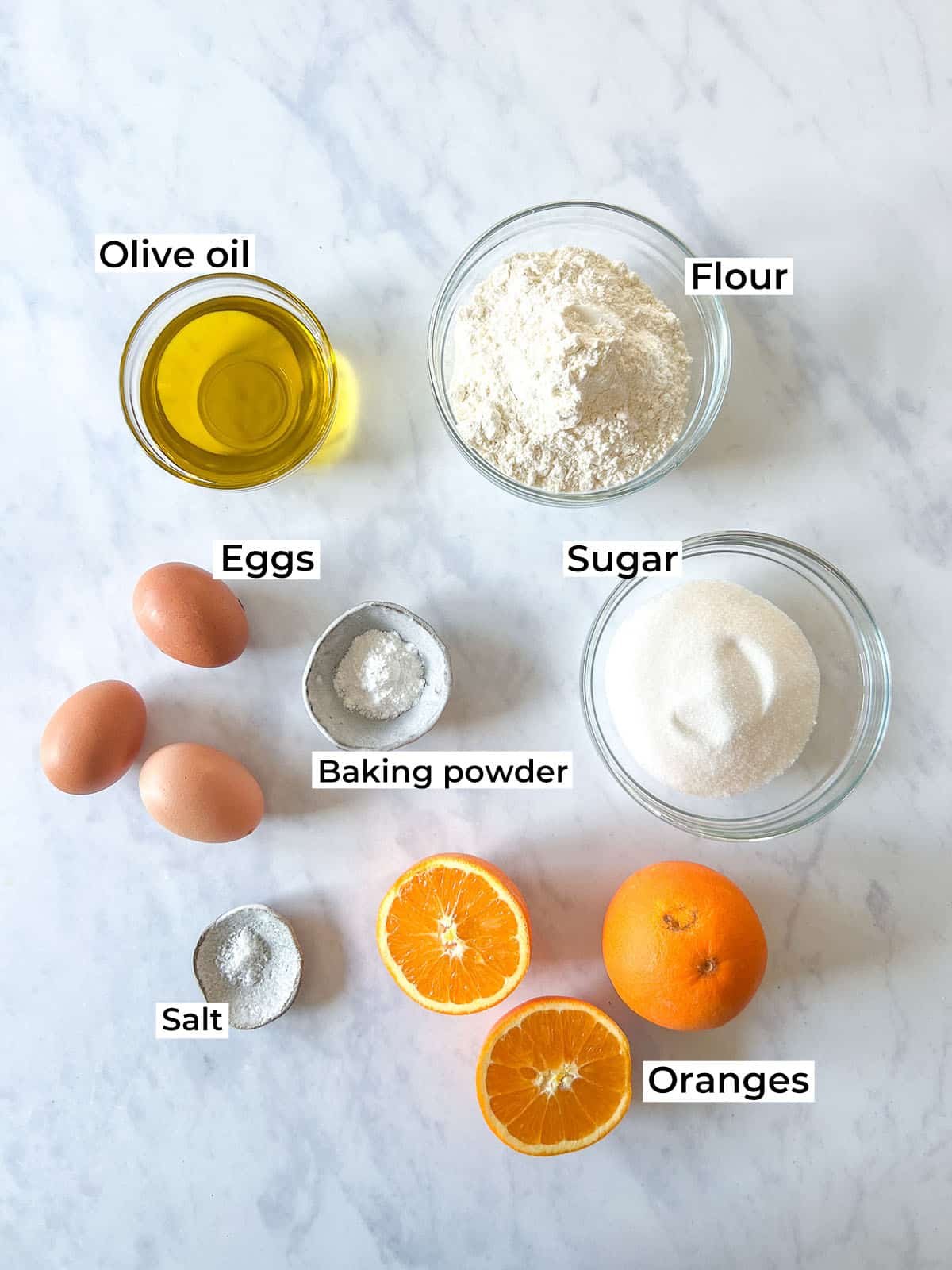
This recipe uses eggs for the perfect balance of texture, flavor, and structure. We urge you to use eggs from free-range hens that are given space to roam and live in more natural conditions compared to caged hens. Choosing free-range eggs supports more humane farming practices, while also providing better flavor and more nutrients because the hens have a more varied and natural diet. When using eggs, we always buy them from a nearby farm that has free-range hens.
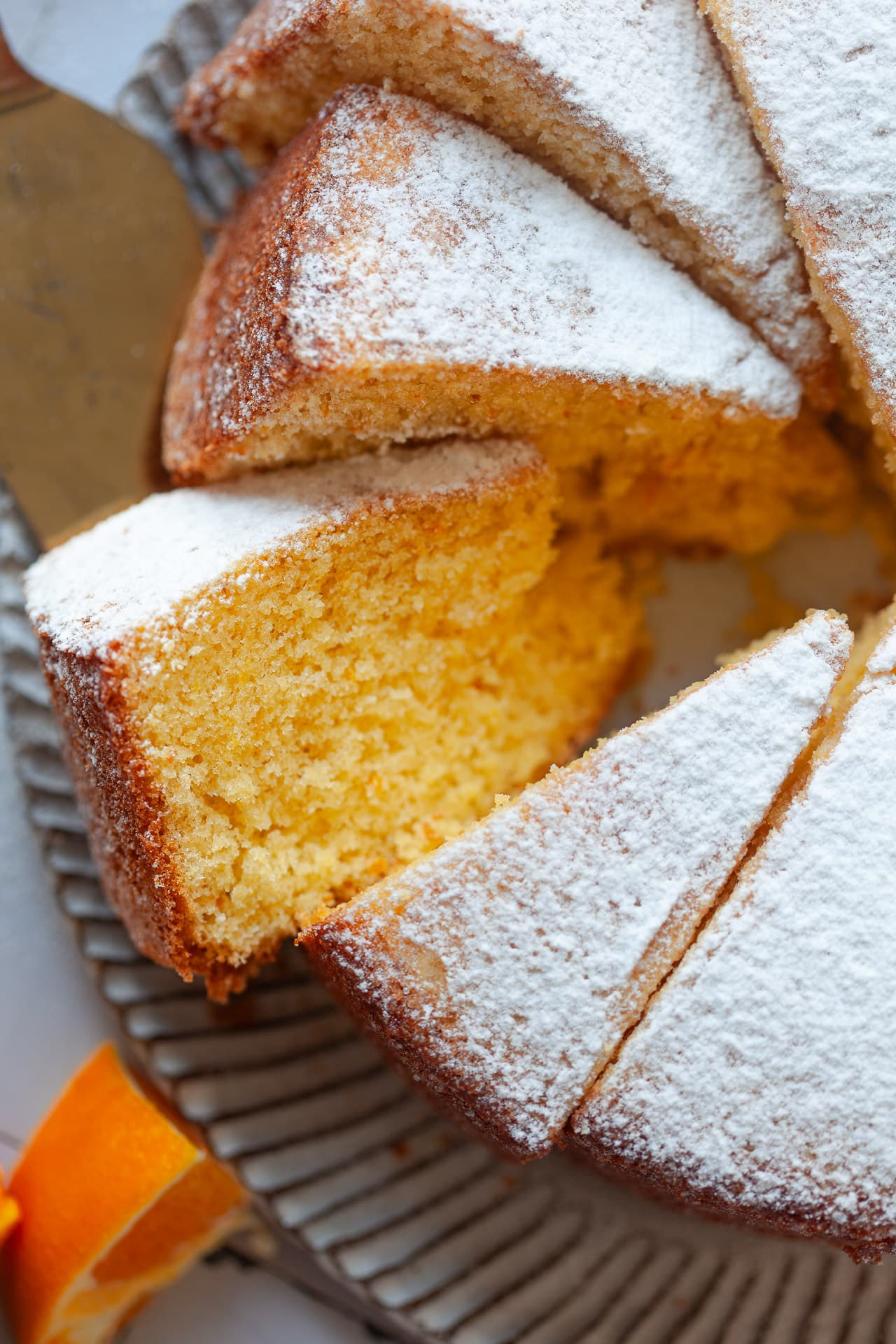
How to make this Olive Oil Orange Sponge Cake
With so few ingredients, this orange cake is really a breeze to make.
Start by preheating your oven to 180°C / 356°F or 160°C / 320°F for fan-assisted ovens. Place the oven rack in the middle to prevent the cake from browning too quickly or unevenly.
Line the bottom of a 22 cm (8-9 inch) round baking tin with parchment paper. Grease the sides lightly with olive oil or a neutral-flavored oil, then dust with flour or sugar. This ensures the cake releases easily after baking. Tap out any excess flour to avoid clumps on the sides of the cake.
Prepare the Egg Mixture:
In a large mixing bowl or in your food processor bowl, crack the eggs (be careful to avoid any shell pieces) and add 3/4 cup granulated sugar.
Using an electric mixer (or straight in your food processor), beat the mixture on medium-high speed for about 8 minutes. You’re aiming for a light and fluffy texture—this will give the cake its airy, tender crumb.
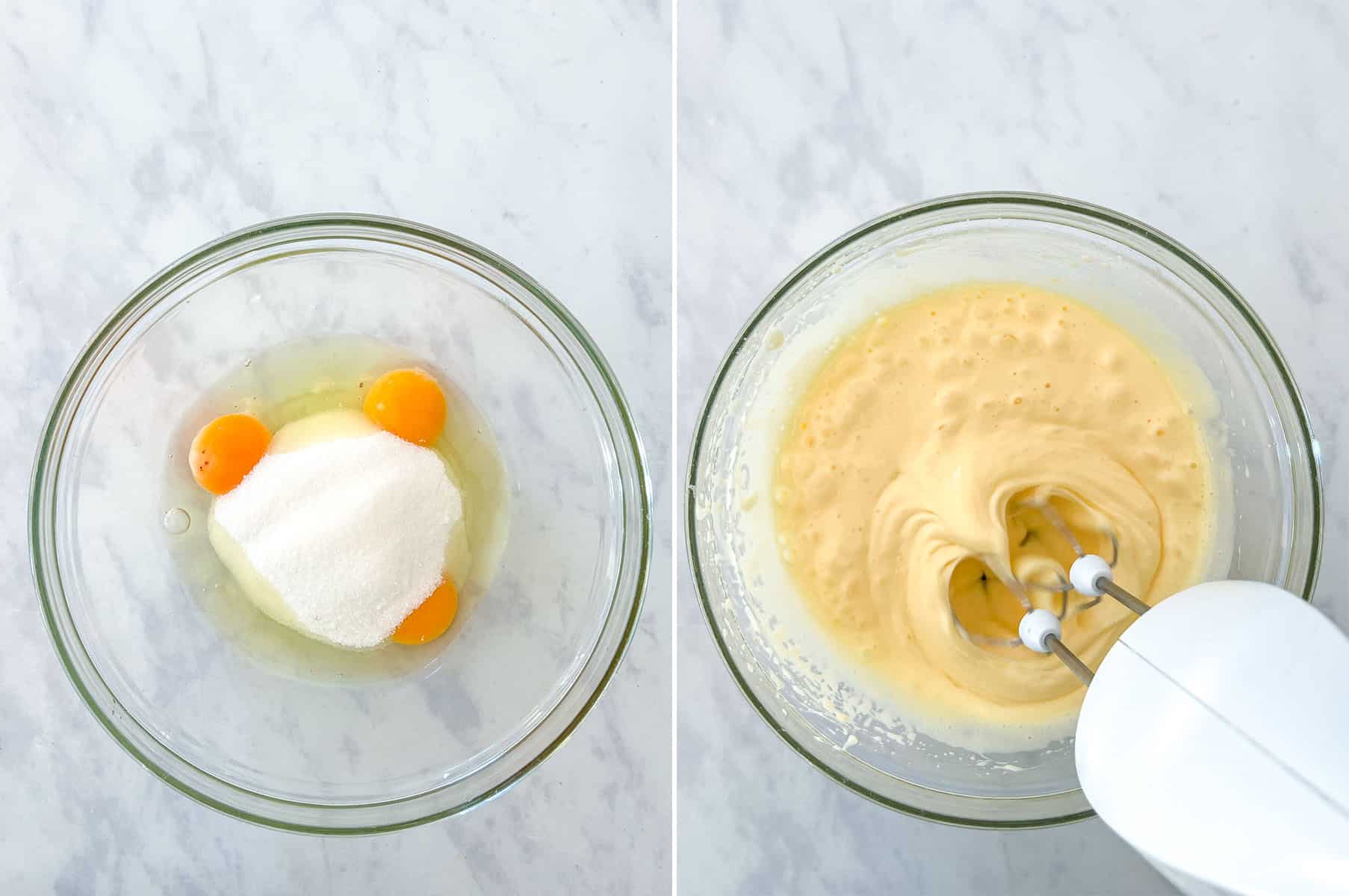
The mixture should triple in volume and look pale yellow.
While the eggs are mixed, zest the oranges using a fine grater (avoid the white pith, as it’s bitter). Then squeeze the juice. Add the zest and juice to the fluffy egg mixture and beat briefly to incorporate.
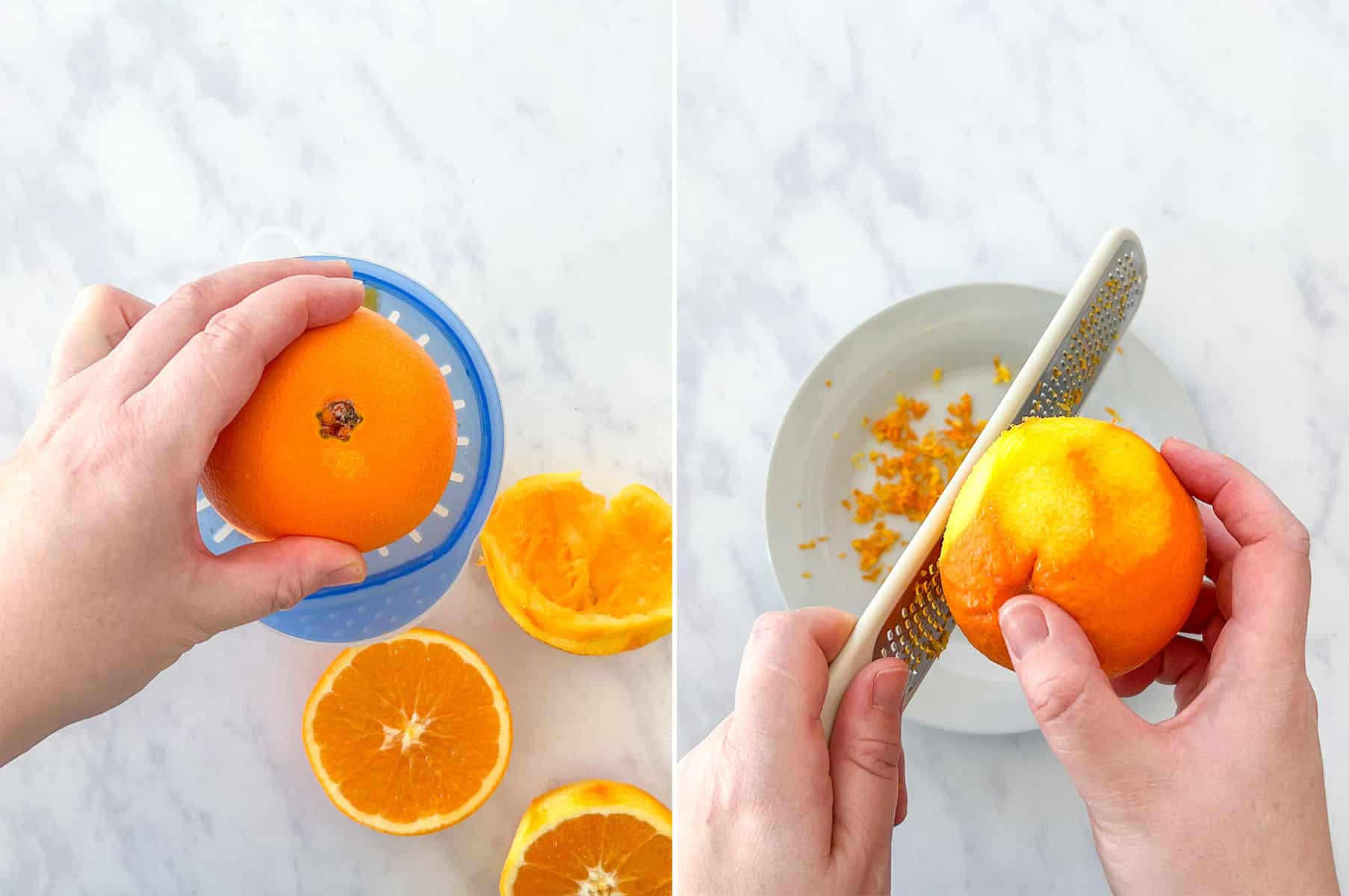
Pour in the 2/3 cup of olive oil in a slow, steady stream while mixing. This ensures the oil emulsifies properly for a smooth batter. Use high-quality, mild olive oil for a subtle flavor that complements the citrus.
Combine Dry Ingredients:
In a separate bowl, whisk together the flour, baking powder, and a pinch of salt. Sifting the dry ingredients into the wet mixture helps to prevent lumps and ensures even distribution.
Add the dry ingredients to the wet mixture in batches, folding them in gently with a spatula. Use a circular motion, lifting the batter from the bottom to avoid deflating the air you’ve incorporated. Overmixing will make the cake dense, so stop as soon as no streaks of flour remain.
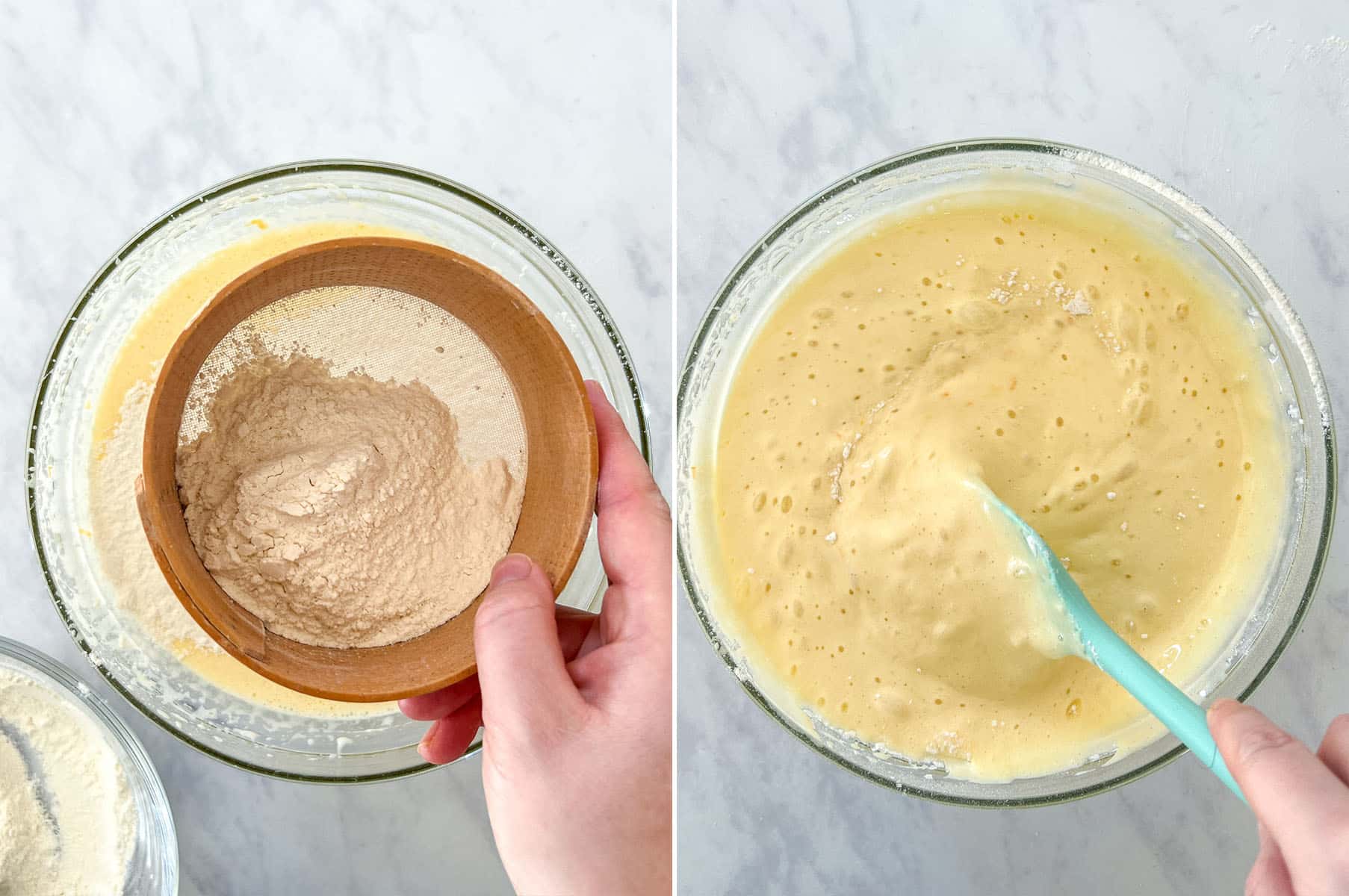
Bake:
Pour the batter into the prepared tin, smoothing the surface with a spatula. Place the tin in the preheated oven and bake for 35-40 minutes. To test when the cake is done, insert a toothpick into the center; if it comes out clean or with a few moist crumbs, the cake is ready.
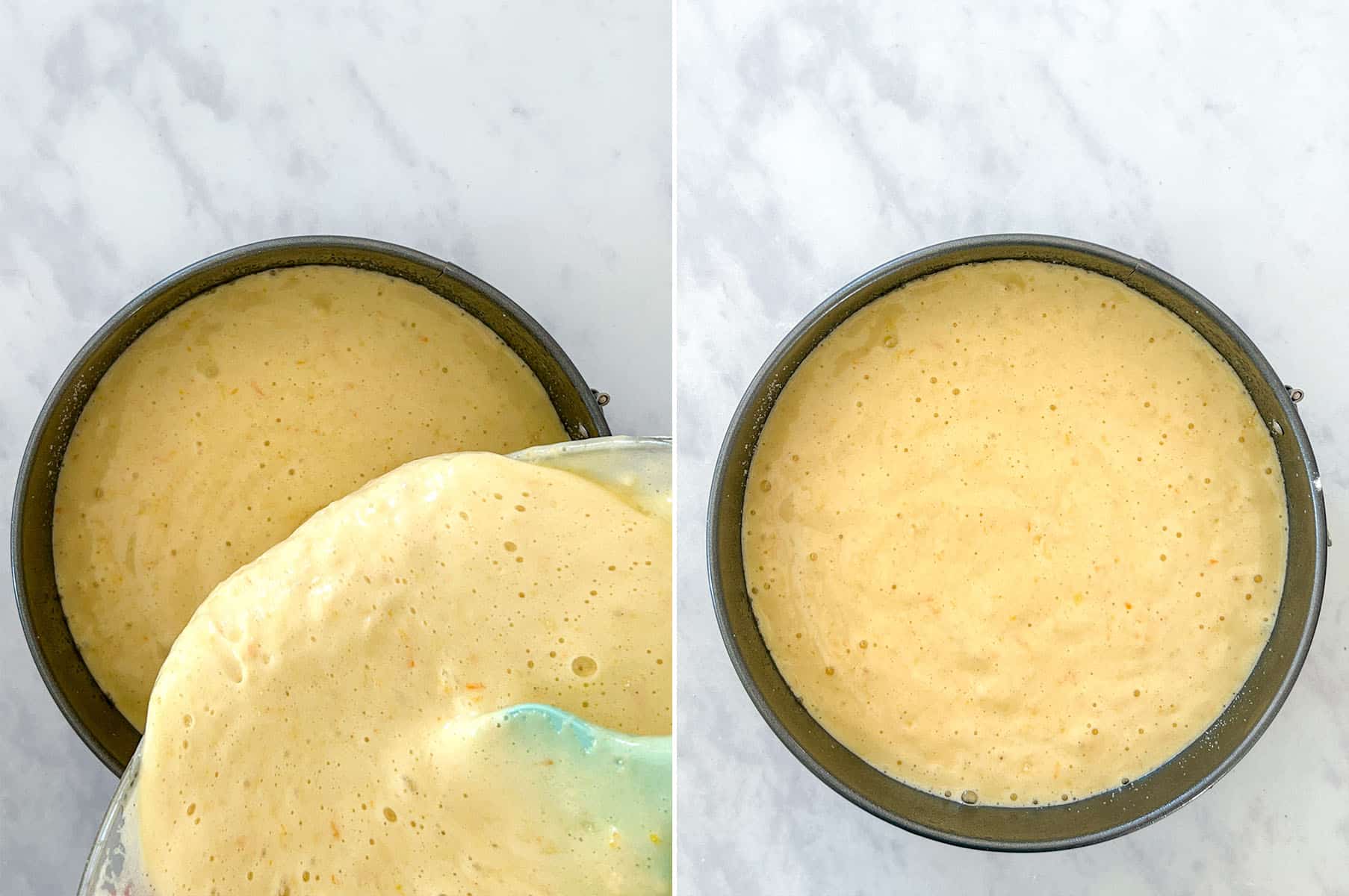
If the top starts browning too quickly, loosely cover the cake with foil during the last 10 minutes of baking.
Cool Down:
Remove the cake from the oven and let it cool in the tin for about 10 minutes. Then carefully run a knife around the edges and transfer the cake to a wire rack to cool completely. Cooling on a rack prevents the bottom from becoming soggy.
Once the cake has cooled, dust the top lightly with icing sugar, slice, and serve.
And that’s all! This is the perfect dessert for when you don’t want to fuss around the kitchen a lot, but want your coffee cake on the table pronto.
And if you’re feeling fancy, try baking this olive oil orange cake in a bundt cake baking tin, or even make mini bundt cakes or baked donuts!
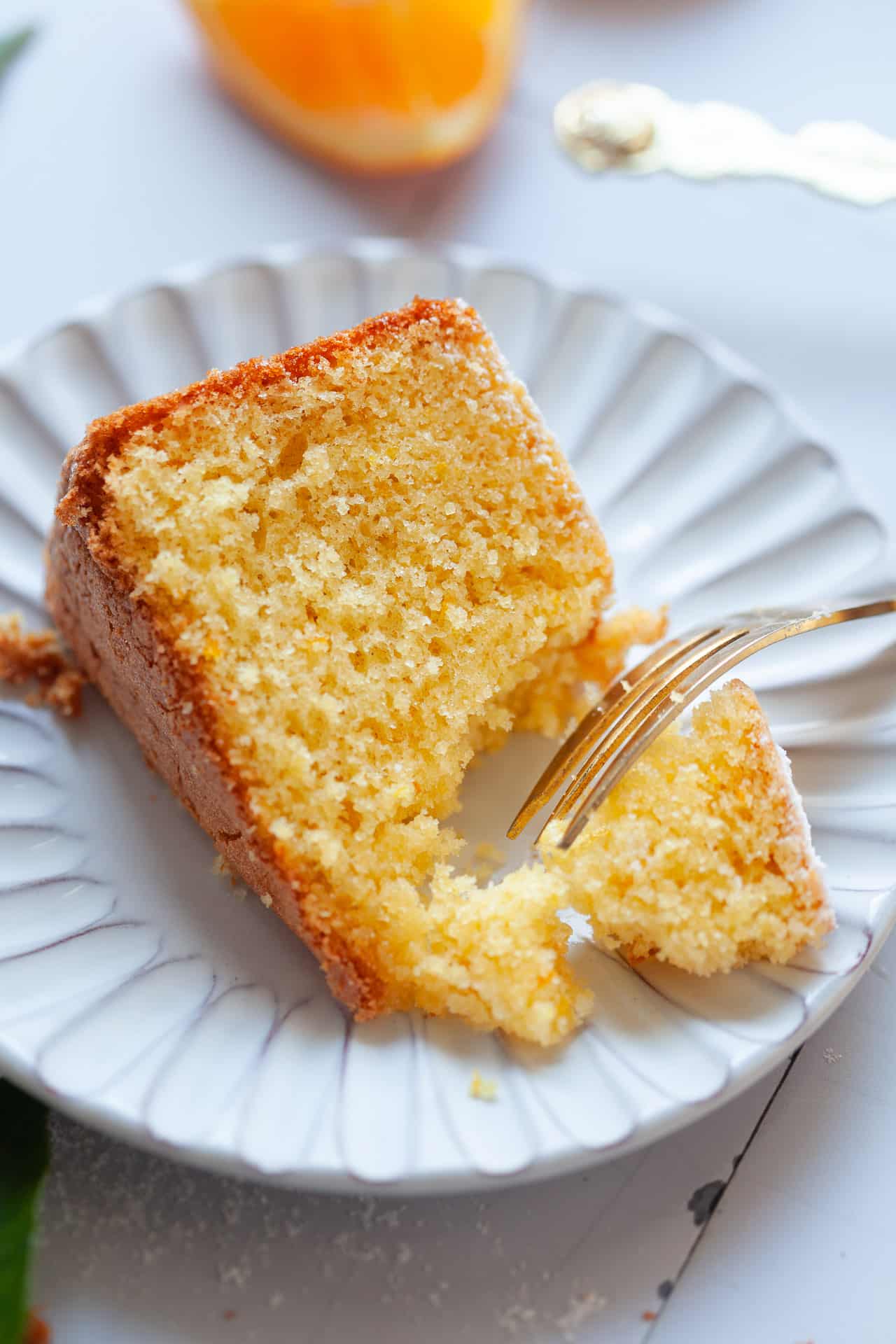
Here’s also the video recipe for this easy Olive Oil Orange Cake with step-by-step procedure!
Serving ideas
This sponge cake can be served by simply dusting it with powdered sugar and serve with a cup of coffee, tea, or hot chocolate. Garnish with a small slice of orange or a sprig of mint for a fresh touch.
Other simple and tasty serving ideas:
- Drizzle a light glaze made of powdered sugar and orange juice over the top for extra citrusy sweetness. Add candied orange peel or zest for decoration.
- Serve with a side of fresh orange segments, berries, or a mixed fruit salad.
- Top the cake with a dollop of dairy-free whipped cream and a few berries for an elegant dessert.
- Melt a bit of dark chocolate (dairy-free if needed) and drizzle it over the slices. Pair with a scoop of vegan vanilla or almond ice cream for a warm-and-cold dessert experience.
- Pair with a dollop of vegan yogurt and a sprinkle of granola for a wholesome breakfast or brunch
- For a festive touch, top with sugared cranberries and serve alongside a glass of sparkling wine or prosecco.
- Slice the cake in half horizontally and spread a layer of orange marmalade or vegan cream cheese frosting between the layers.
- Cut the cake into small squares or fingers and serve with a drizzle of honey or maple syrup for a kid-friendly treat.
Storage tips
Store leftovers in an airtight container at room temperature for up to 5 days. For longer storage, wrap individual slices in plastic wrap and freeze for up to 3 months. Simply thaw at room temperature when ready to enjoy.
Room Temperature Storage:
Place the cake in an airtight container or wrap it tightly with plastic wrap to keep it from drying out. Store at room temperature for up to 3 days in a cool, dry place away from direct sunlight.
Refrigeration:
If you live in a warm or humid environment, refrigerate the cake to prevent spoilage. Wrap it well in plastic wrap or store it in an airtight container to protect it from absorbing other fridge odors.
The cake can be refrigerated for up to 5 days. Bring it to room temperature before serving to enjoy its best flavor and texture.
Freezing:
For longer storage, freeze the cake. Slice it into individual portions to make it easy to thaw just what you need.
Wrap each slice tightly in plastic wrap, then place the slices in a freezer-safe bag or container to prevent freezer burn. The cake can be frozen for up to 3 months.
Thawing:
To thaw, remove the desired number of slices from the freezer and let them sit at room temperature for 1–2 hours. You can also microwave slices for 10–15 seconds to warm them slightly if desired.
If the cake looks a little dry after storage, you can lightly dust it with fresh icing sugar or drizzle with orange glaze to restore moisture.
More similar recipes:
Dairy-Free Strawberry Yogurt Cake
Vegan Carrot Cake with Cream Cheese Frosting
Vegan Double Chocolate Zucchini Bread

This recipe was updated in 2024 with new information, pictures and step by step instructions.

Olive Oil Orange Cake {Dairy-Free}
A simple, delicious, dairy-free Olive Oil Orange Cake is light and fluffy with a strong orange flavor.
Ingredients
- 3 eggs
- 3/4 cup (150 grams) granulated sugar
- 2 small organic oranges
- 2/3 cup (160 ml) olive oil
- 1 1/2 cup (200 grams) all-purpose flour
- 2 tsp baking powder
- pinch of salt
- icing sugar to dust
Instructions
- Preheat oven to 180°C/356°F (fan oven 160° / 320°F).
- In a large bowl, crack eggs (discard shells), add 3/4 cup granulated sugar, and mix with an electric mixer for about 8 minutes, until the eggs and sugar are thoroughly combined in a light and fluffy foamy mix.
- While the eggs are being beaten, grate orange zest and squeeze the juice out of 2 small organic oranges. Add both to the foamy egg mixture, then also add 2/3 cup of olive oil and mix for another minute to combine.
- In a separate bowl, combine 1 1/2 cup flour, 2 tsp baking powder, and a pinch of salt. Sift on the egg mixture and fold in gently with a spatula by hand.
- Cover the bottom of a round baking tin (fi 22 cm / 8-9 inches) with baking paper, and grease the sides with a bit of oil, then dust lightly with flour to prevent sticking. Pour batter into baking tin and place in preheated oven to bake for about 35-40 minutes. Check with a toothpick when your cake is baked.
- Remove the baked cake from the oven, take it out of the baking tin, and place it on a rack to cool down. Once cooled, dust with icing sugar to decorate, and serve.
- Store in an air-tight container for up to 5 days.
Notes
2 small oranges = about 1/2 cup (125 ml) of juice + 1 tbsp orange zest.
Nutrition Information:
Yield: 10 Serving Size: 1Amount Per Serving: Calories: 332Total Fat: 16gSaturated Fat: 3gTrans Fat: 0gUnsaturated Fat: 13gCholesterol: 56mgSodium: 133mgCarbohydrates: 44gFiber: 1gSugar: 28gProtein: 4g
Nutrition data is automatically calculated using Nutritionix and may not be accurate.
